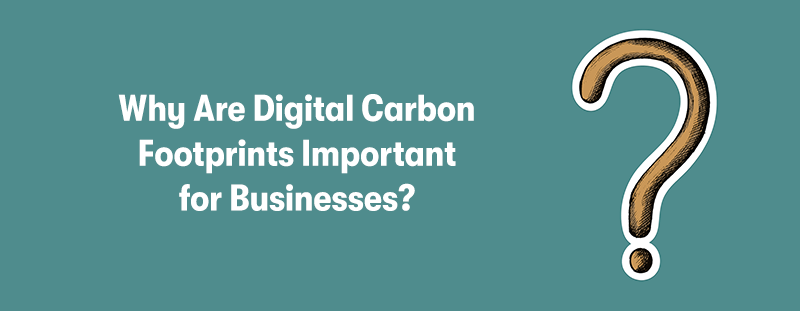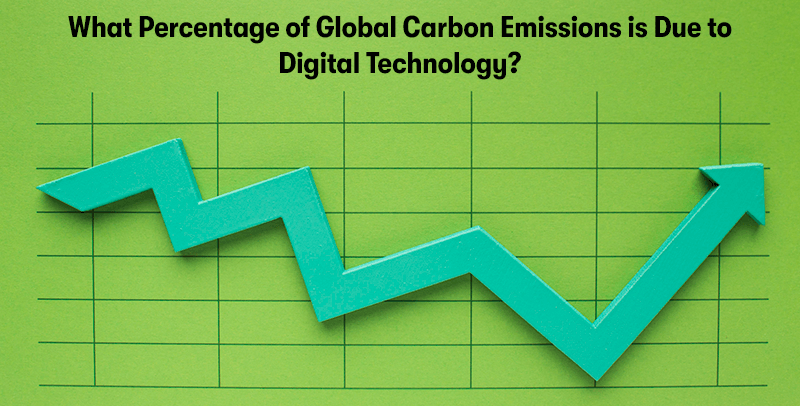What is a Digital Carbon Footprint?
Welcome to our exploration of a pressing yet often overlooked aspect of our digital age: the Digital Carbon Footprint. In an era where technology seamlessly intertwines with every facet of our lives, it's imperative to understand the environmental impact of our digital existence. This concept encompasses the carbon dioxide emissions resulting from the use and production of digital technologies - including devices, data centres, and the vast networks that connect us.
As our reliance on digital solutions grows, so does the urgency to acknowledge and address this invisible yet significant contributor to global carbon emissions.
Join us as we delve into the intricacies of digital carbon footprints, unravelling why they matter and how their understanding can guide us toward more sustainable technological practices.
What is a Digital Carbon Footprint?

A Digital Carbon Footprint refers to the amount of carbon dioxide emissions associated with digital activities. This includes the energy consumed by digital devices, data centres, and communication networks. Here's a breakdown of the various elements that contribute to a digital carbon footprint:
Devices
Electronic devices such as smartphones, computers, and tablets consume electricity, contributing to carbon emissions. Their production, usage, and disposal processes also have environmental impacts.
Data Centres
These are the hubs where internet data is processed and stored. They consume significant energy for running servers, data storage, network infrastructure, and cooling systems to prevent overheating.
Networking
This includes the energy used by the infrastructure that connects different parts of the internet, like routers, switches, and the transmission networks that carry data.
Cloud Computing
Services provided over the internet, like streaming, cloud storage, and online gaming, rely on data centres and network infrastructure, thus contributing to the digital carbon footprint.
Content Delivery
The process of delivering content, like videos, music, and websites, to end-users also involves energy consumption, especially for data-intensive applications.
E-Waste
The disposal of electronic devices contributes to the digital carbon footprint. Improper disposal can lead to harmful materials entering the environment, while recycling processes also consume energy.
Lifecycle Emissions
The lifecycle of digital devices and infrastructure involves emissions from manufacturing to disposal. This includes extracting raw materials, manufacturing, transportation, usage, and end-of-life processes.
Reducing the digital carbon footprint involves improving energy efficiency, using renewable energy sources, optimising data management, and promoting sustainable practices in the manufacturing and disposal of electronic devices. As digital technology becomes more pervasive, understanding and managing its environmental impact is increasingly important.
Why Are Digital Carbon Footprints Important for Businesses?

Digital carbon footprints are important for businesses for several reasons, reflecting a blend of environmental, economic, and social considerations:
Environmental Responsibility: As awareness of climate change and environmental issues grows, businesses are increasingly expected to minimise their impact on the planet. Reducing their digital carbon footprint is a significant step towards this goal. It demonstrates a commitment to sustainability, which is important not only for the environment but also for increasingly environmentally conscious stakeholders.
Regulatory Compliance
Governments and international bodies are setting stricter regulations and guidelines on carbon emissions. By actively managing and reducing their digital carbon footprint, businesses can ensure compliance with these regulations, avoiding potential fines and legal issues.
Cost Savings
Energy efficiency directly correlates with cost savings. By optimising their digital operations, businesses can reduce their energy consumption, lowering utility bills. This is especially relevant for data centres, cloud services, and extensive digital networks.
Corporate Image and Brand Value
Committing to reducing their digital carbon footprint can enhance a company's brand image and reputation. Consumers and clients are increasingly favouring environmentally responsible businesses, which can be a key differentiator in competitive markets.
Investor Attraction
Investors are increasingly looking at the environmental impact of companies. A lower digital carbon footprint can make a business more attractive to investors who are concerned about sustainability and long-term environmental risks.
Employee Engagement and Attraction
Many employees, especially from younger generations, prefer to work for companies committed to environmental sustainability. Demonstrating a commitment to reducing a digital carbon footprint can help in attracting and retaining talent.
Risk Management
Addressing the digital carbon footprint is also a matter of risk management. With climate change posing various risks (like regulatory, physical, and market risks), reducing carbon emissions can help mitigate these risks.
Innovation and Efficiency
Focusing on reducing the digital carbon footprint drives innovation. It encourages businesses to find new, more efficient ways of operating digitally, which can lead to discovering more effective business processes and technologies.
Market Competitiveness
As sustainability becomes a more prominent factor in consumer decisions, businesses that have actively reduced their digital carbon footprint may have a competitive advantage in the market.
In summary, managing and reducing digital carbon footprints aligns with a broader shift towards sustainability, offering businesses benefits ranging from cost savings and regulatory compliance to improved brand value and market competitiveness.
How to Reduce Your Digital Carbon Footprint?

Reducing a business's digital carbon footprint involves a combination of strategies focused on energy efficiency, sustainable practices, and informed decision-making. Here are some effective ways to achieve this:
Energy-Efficient Equipment
Use energy-efficient devices and servers. Look for products with energy-saving features or certifications like ENERGY STAR. Upgrading older equipment can significantly reduce energy consumption.
Optimise Data Storage
Store data efficiently by regularly cleaning up unnecessary files and decommissioning unused servers. Use data deduplication and compression techniques to minimise the space required.
Cloud Computing
Consider moving to cloud services, as cloud providers often have more efficient, larger-scale infrastructure that can reduce overall energy consumption compared to traditional on-premise data centres.
Renewable Energy Sources
If possible, power your operations with renewable energy sources. Encourage your cloud or data centre providers to use green energy.
Server Virtualisation
Virtualise servers to ensure that physical servers are used to their maximum capacity, reducing the number of servers required and thus saving energy.
Efficient Cooling Systems
Data centres require cooling to prevent overheating. Implementing efficient cooling techniques and optimising the data centre layout can significantly reduce energy use.
Telecommuting and Remote Work
Encourage remote work where feasible. This reduces the energy consumption in office spaces and reduces emissions from commuting.
Green Web Hosting
Choose web hosting services that are committed to sustainability, such as those using renewable energy or practising carbon offsetting.
Digital Product Design
Design digital products and services to be efficient in terms of data usage and processing power, which in turn reduces energy consumption.
E-Waste Management
Properly recycle and dispose of electronic waste. Consider donating or refurbishing old equipment instead of discarding it.
Employee Education and Engagement
Educate employees about the importance of reducing digital carbon footprints. Encourage practices like shutting down computers when not in use, efficient digital file management, and mindful printing.
Monitor and Measure
Regularly monitor and audit your digital infrastructure to identify areas where energy is wasted and track improvements.
Sustainable Procurement Policies
Develop procurement policies that prioritise environmentally friendly digital products and services.
Reduce Digital Bloat
Streamline online content to avoid excessive data transfer. This includes optimising website images and videos for efficient loading.
Energy-Efficient Software Development
Optimise software for energy efficiency, especially for high-performance applications.
By implementing these strategies, businesses can significantly reduce their digital carbon footprint, contributing to a more sustainable future while often realising cost savings and efficiency improvements.
Where Can You Study Digital Sustainability?
At Purple Griffon, we offer an ITIL® 4 Specialist Sustainability in Digital & IT (SDIT) training course. This course will help you to:
- Understand how to use the ITIL guiding principles to deliver value by creating sustainable digitally enabled products and services.
- Effectively address VUCA challenges through sustainable strategies, procurement, products and practices.
- Obtain a practical grounding in the key principles of sustainability.
- Conduct a complete cost-benefit analysis identifying potential risks and opportunities using best practice guidance.
What Percentage of Global Carbon Emissions is Due to Digital Technology?

In 2023, digital technology was estimated to account for about 2% to 4% of global carbon emissions. This range, however, is subject to change over time due to the rapid growth and evolving nature of digital technologies. To break this down further:
Data Centres
They were estimated to contribute around 1% of global carbon emissions. Their energy consumption is significant due to the need for continuous operation, cooling systems, and the energy-intensive nature of large-scale data processing and storage.
Networks and Infrastructure
The global IT network, including telecommunications networks, also contributes a substantial portion of the emissions from digital technology.
Devices
End-user devices like smartphones, computers, and tablets, along with their production, use, and disposal, contribute to the carbon footprint of digital technology.
It's important to note that these figures are constantly evolving. The increasing efficiency of digital technologies and the shift towards renewable energy sources can reduce the carbon footprint. In contrast, the expanding use of digital services and devices could lead to an increase in emissions. Additionally, methodologies for calculating these emissions are continually refined, which might also affect the estimated percentages.
What Are the Benefits of Reducing Your Company's Digital Carbon Footprint?

Reducing your company's digital carbon footprint offers a range of benefits that extend beyond environmental sustainability. These benefits encompass economic, social, and operational aspects:
Cost Savings
Reducing energy consumption directly translates to lower operational costs. Energy-efficient practices in digital operations, such as using more efficient hardware or optimising data storage, can lead to significant savings on electricity bills.
Enhanced Brand Image and Reputation
Demonstrating a commitment to sustainability can strengthen your company's reputation. Consumers and businesses are increasingly aware of environmental issues and often prefer to engage with environmentally responsible companies.
Competitive Advantage
A reduced digital carbon footprint can be a point of differentiation in your industry. It can attract environmentally conscious customers and can also be a deciding factor in business partnerships, as companies often prefer to work with green suppliers.
Compliance and Risk Mitigation
As governments worldwide impose stricter regulations on carbon emissions and environmental sustainability, reducing your digital carbon footprint can help ensure compliance with these regulations, thus avoiding fines and legal issues.
Investor Appeal
Many investors are now considering environmental factors when making investment decisions. A lower digital carbon footprint can make your company more attractive to a growing segment of socially responsible investors.
Employee Morale and Recruitment
A commitment to sustainability can improve employee morale, as many prefer to work for a company that aligns with their values. It can also be an attractive factor for potential new hires.
Operational Efficiency
Efforts to reduce a digital carbon footprint often lead to more efficient operational processes. This can include better resource management, innovative use of technology, and streamlined workflows.
Market Readiness
Being ahead in reducing your digital carbon footprint prepares your business for a future where such practices might become the norm, ensuring long-term viability and relevance in a changing market.
Contribution to Global Climate Efforts
By reducing your digital carbon footprint, your company contributes to global efforts to mitigate climate change, helping to preserve the environment for future generations.
Improved Stakeholder Relations
Commitment to environmental sustainability can strengthen relationships with customers, suppliers, employees, and the community, fostering goodwill and positive relationships.
Innovation and Learning
Reducing your digital carbon footprint can drive innovation within the company, as it often requires new, creative approaches to technology and business processes.
In summary, reducing a digital carbon footprint is not just an environmental initiative; it's a strategic business decision that can lead to cost savings, enhanced reputation, improved operational efficiency, and better stakeholder relationships.
Final Notes on Digital Carbon Footprints
In conclusion, understanding and managing a digital carbon footprint is crucial in today's technology-driven world. Not only does it reflect a company's commitment to environmental sustainability, but it also brings a plethora of benefits, including cost savings, enhanced brand reputation, competitive advantage, and compliance with regulatory standards. Businesses play a vital role in this domain, from the significant contribution of digital technology to global carbon emissions to the strategies for reducing this impact.
Companies can significantly lower their digital carbon footprint by adopting energy-efficient practices, optimising digital operations, and embracing innovative solutions. This proactive approach is not just a responsibility towards the environment but a strategic move towards a more sustainable, efficient, and future-ready business model.
Remember, every step towards reducing digital carbon emissions counts towards a greener, more sustainable future.


